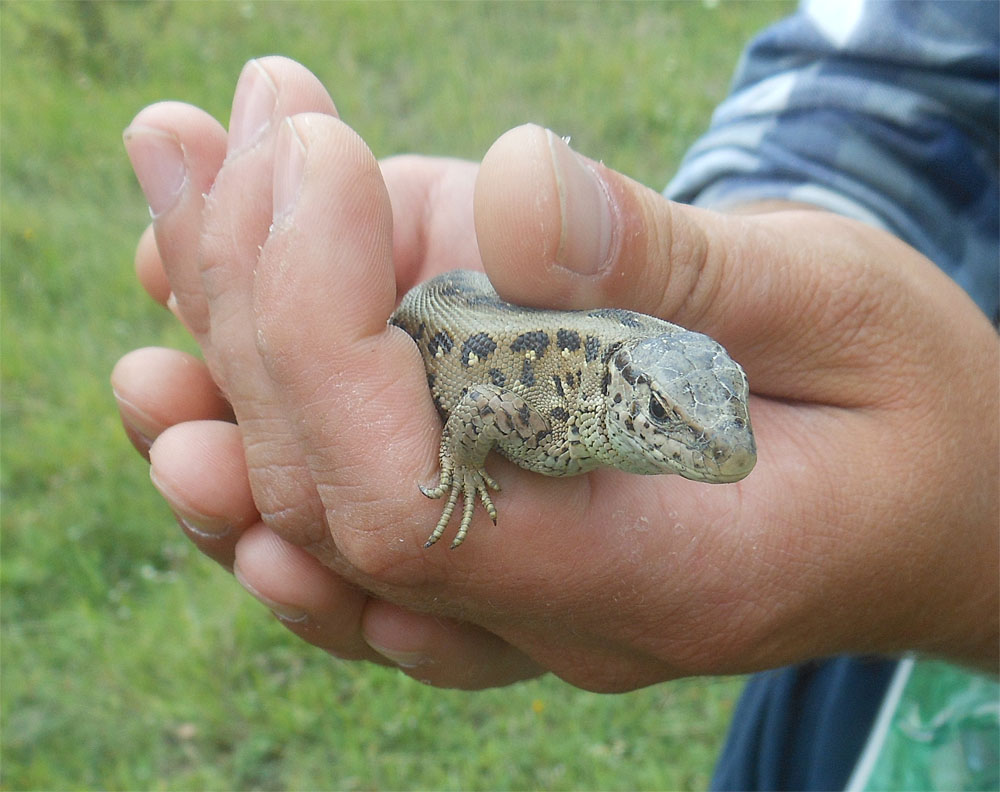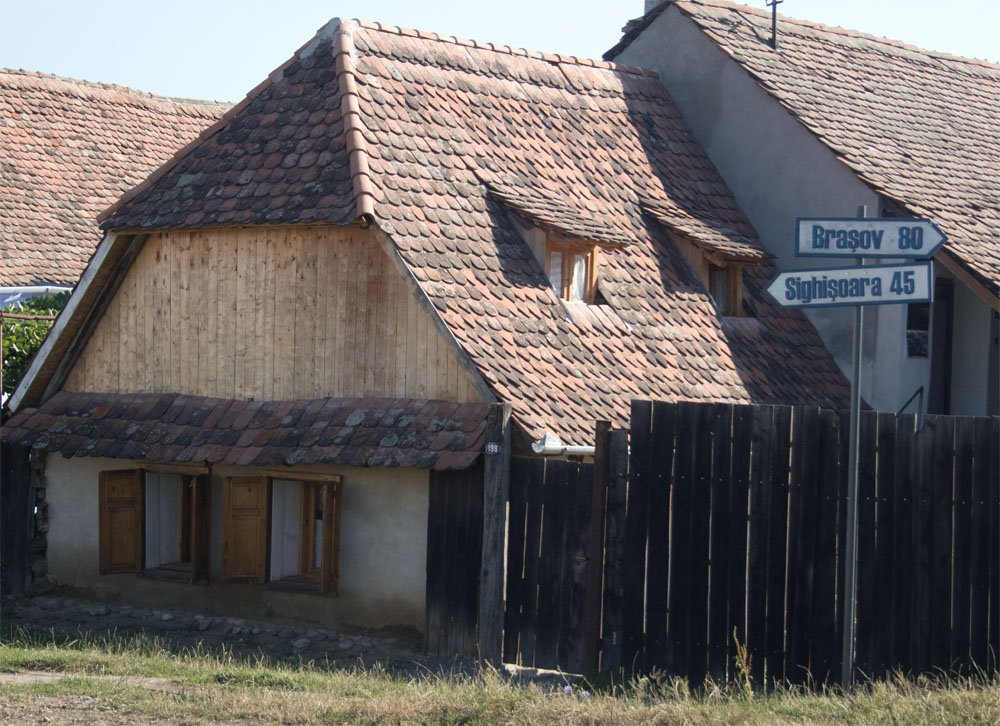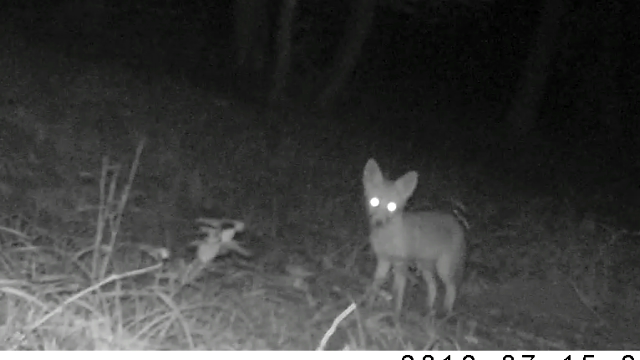June – August 2016
The peace is superficial. From Viscri’s high ridges, you can see the land folding higher and ever higher into the Carpathians – but something is in the foreground. It has hooves.

Livestock explains a lot about Viscri. Modernisation has boosted sheep, perhaps for the wool to knit those socks for tourists. Not only is the sheep / cow ratio skewed, but the actual sheep flocks are also much bigger.

More hooves to trample the meadows, and more mouths to eat it. The grass is cropped low with sharply reduced biodiversity. The only exception is within a rusty barbed wire fence: a tiny but gorgeous meadow saved by the local beekeeper for his bees.

With so few mammals, reptiles take over my surveys. Sand lizards are abundant.

Something doesn’t feel right. Wild boar bones litter the wood – someone has been poaching. I’ve got a bad feeling about leaving the trail cameras here.
Perhaps it’s fitting that Viscri has a signpost to Brasov, arguably the most famous flashpoint of human-wildlife conflict in Europe.

Because we’re about to land fair and square in conflict of our own…

July 15th
The cows are coming home. I can hear them mooing from my room. A less common event in town is the decorating of a gate with conifer branches and balloons. Men were playing eastern-sounding music as they worked. There will be a wedding tomorrow.
July 19th
Dogs. Sheep. East Transect.
The skies are grey with fluctuating patches of blue, painting random lighted patches on the green landscape.
Fluffy cotton wool – or rather, dirty cotton wool. Sheep are dotted on the overgrazed grass in a flock both coherent and borderless.
The track rises swiftly over what might be an esker. What is this? Heads pop up. Heads, heads, heads. Giant dogs burst forth, barking. But the numbers! There are eleven, at least, although I don’t remember counting, and each is the size of an English mastiff or bigger. They flow towards us like an army out of Narnia: white and brown, or grey, or white, with massive St Bernard heads and torn ears. Some are like Spanish mastiffs, but with longer, unkempt coats.
We have no stick. We have no pepper spray.
I don’t make eye contact with the dogs and feel nothing. Time blends into a swirl. So much barking. Occasionally I notice a passing dog with angry eyes and barking jowls – the pack has encircled us. No elk ever brought to bay by wolves was so trapped, but then, elk that stand still are those that survive.
Some while later, the shepherd ambles over. He displays no concern whatsoever. He is perhaps in his forties, with a brimless black hat, an overcoat loose over his shoulders, and a large plastic bottle of something that looks like Pepsi but is probably beer. His dogs release us. We’re out of here.
Trailcams 1, 2, 3 – we ascend the ridge, and grab them. The good news is that one caught a fleeting glimpse of a forest wildcat carrying reptilian prey. We also have a rather cute fox.

The bad news is Trailcam 4. A chain dangles sadly from where the camera used to be. It’s now in a poacher’s pocket.
With the surviving cameras and low spirits, we walk on through the wood, trying to find a route home away from the dog pack. With the utmost difficulty, we crawl through dense prickling hawthorn, only to find ourselves dangerously close to the notorious farm with the red roofed barns.

New problem: cows litter the landscape. Even at four hundred metres, another pack of giant dogs spot us, and come charging, bounding into hedgerows, closer, ever closer. Baskerville would be proud. One – something like a long-haired Anatolian – closes the gap to perhaps 60 metres, barking, barking, barking…
Scratched, exhausted and overheated, we stumble back into camp. Our local friends are horrified to hear that Trailcam 4 has been taken and with an energy that would leave the CID in the dust, they vow to track down the culprit. But there’s nothing more I can do.
Roll on Malancrav. That will be all.
It sounds as though you’re moving into more “modern” areas, Adele … I’d have been glad for them to see my back. The photos are really nice … there seems to be more atmospheric haze here than in previous places … is it perhaps possible that the close cropping of the fields (a common problem with sheep) exposes the soil to more transpiration of moisture, causing more haze?
LikeLiked by 1 person
That is an interesting hypothesis. It seems quite plausible. My immediate irritation with sheep is their impact on wild mammals but of course their environmental impact is broader.
Viscri is a strange place. It is as much of Transylvania as the most adventurous tourists ever see, and compared to western Europe, appears untouched – but the truly remote villages are very different. I went dramatically to the other extreme for the two weeks following this, to the most remote areas included in the survey programme.
As an aside, it took a long time after this for me to see a herd of sheep (even in England!) and not start looking around for guard dogs!
LikeLike
Such beauty abounds here, wonderful photos!
LikeLiked by 1 person
Thank you Pete 🙂 This Romanian expedition was a truly amazing experience and gave me a lot of food for thought about how the UK’s landscapes can be managed better for biodiversity. I hope you had a nice Christmas, by the way!
LikeLiked by 1 person
You are welcome, Adele. I am enjoying a quiet Christmas week, which is how I like it thank you 🙂 I hope you are enjoying a peaceful and happy Christmas yourself.
LikeLike
Adele, A beautiful country indeed, but underneath dark shadows lurk. Hope you have a great New Years!
LikeLiked by 1 person
Thanks Robin – hope you had a good Christmas!
The saga of Trailcam 4 will be continued 😉 I think every expedition has one day you wish to forget, and for me in Romania, that was the afternoon where not only was the camera stolen but we got chased by these two monstrous packs of dogs. I was on a different project this year but I gather that the scientists working in Romania got attacked by the same dog pack. It would be useful if the shepherd could put down his beer and get his dogs under control!
LikeLike
Most of my life, I lived in Balkan peninsula and I must say that attitude of people living in Balkan countries is more-less the same: unless something really bad happens, nothing will change. People as well as local authorities doesn’t like the change: it brings “unnecessary” additional work for the same salary and may bring the change in the way the things are done and worked for so long. I hope you understand what I mean, I can recognize a pattern even through your writing. So sad.
LikeLike
Hi Darko, yes, I understand, and it is sad.
Something does really need to be done about the dog packs; apart from the danger to people, they also kill wildlife, even taking down deer, but I do not believe that the situation will change. I understand it’s the law in Romania that a shepherd must only have two dogs, but even in touristy Viscri, it’s not enforced. After this, I went to Malancrav, which was full of lawlessless and no-go areas. Ironically, it had better wildlife…
LikeLike
Recently, I’ve seen some trail cams with ability to upload photographs and movies straight to your cell phone or cloud. Too bad you didn’t have that ability at hand. However, some kind of cell phone network is required and I doubt you had a good service in such a remote areas.
LikeLiked by 1 person
I have looked into those but what worries me is the ongoing costs associated with the messaging. I don’t mind paying a few cents to receive an exciting photo of a bobcat or wolf, but when I was doing my MSc project in Saskatchewan, I had upwards of 10,000 photos where the camera was triggered by waving grass. Receiving all those by email or SMS is a scary thought!
LikeLike
Oh, I didn’t think about that :doh:
LikeLike